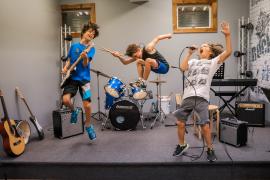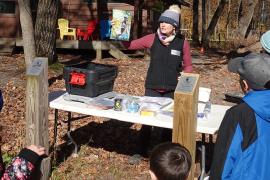Many campers as young as three and four years of age engage in many of the same sports activities as their older counterparts. Sports such as soccer, tennis, basketball, and hockey are routinely part of a camp schedule. Many sport specialists ask for the youngest children not to come to them, because they believe the children do not get anything out of the activity. Some activity directors may also believe that scheduling children this young for sport specialist activities is a waste of time.
Nothing could be further from the truth — three- and four-year-old campers may actually get more out of going to these activities than the nine- or ten-year-old camper. Although these young children are capable of doing many of the same sport activities as older children, adjustments need to be made to make these sport activities more developmentally appropriate. Games should emphasize fun and very basic gross motor skills with a de-emphasis on specific sports skills.
For example, teaching a very young child how to pass a soccer ball and directional kicking may be an exercise in futility. However, teaching them the concept of open space will introduce a basic soccer skill. Teaching tennis to three- and four-year-olds may not even require placing a racquet in their hand. Additionally, there should be a total de-emphasis on competition at this age, and games involving outs should not be played.
A concrete understanding of developmentally appropriate motor development for the three- and four-year-old is the first step in ensuring a successful sports program for these young children. The predominant psychomotor skills that an individual needs to be successful in sports are movement, throwing, kicking, catching, and striking (Nichols 1994). We will review these gross motor skills and give appropriate teaching cues for each. In addition, examples of age-appropriate games will be given for each skill.
Psychomotor Skills
Movement
Three-year-old children may still be labeled clumsy — falling over "their own two feet." This is developmentally appropriate, and often the child needs to slow down and concentrate more on his or her movement. Slower and shorter games often work well with the child who has a propensity towards falling. The four-year-old child should be able to perform the locomotor skills of walking, running, jumping, hopping, galloping, and skipping. Movement games for any sport at this age should emphasize finding personal space, starting and stopping, and exploring different movement patterns (Nichols 1994).
An example of two movement games that can be played at this age are Red Light/ Green Light and Islands. Red Light/Green Light can be enhanced by using red and green paper to help children look up while running. Looking up while running is an extremely important pre-requisite skill to sport participation. When the green paper is shown, they run, walk, skip, or hop, and when the red paper is shown, they stop.
The game of Islands teaches the concept of open space and movement. Place hula hoops or markers around the field or gym and play music and have the children run; when they hear the word "islands" or the music stops, they run or move in the designated way to the hula hoop or marker.
Throwing
Three- and four-year-old children can throw a small ball overhead. They will probably not throw in opposition, and this should be the focus of teaching. Having the children step with their opposite foot and throw with both their right and left arm will help with their motor and sport development (Nichols 1994).
At this age, throwing for distance and not accuracy should be emphasized. Throwing for accuracy will cause children to short arm the ball and not throw through their entire range of motion. Throwing through their entire range of motion is essential for sport success (Nichols 1994).
Games such as Take the Garbage Out and Throwing for Points are developmentally appropriate. In the game of Take the Garbage Out, children are placed on either side of a basketball court or tennis court. Using a very soft ball, children must throw the ball to the other side. Throwing for Points is a great tennis lead-in game. The children take a tennis ball and points are designated for certain spots. They get points based on where their throw lands. Again emphasis is on distance, so make spots large. At any age, but especially at this age, human targets should never be used. Games such as dodge ball should not be played at this age group.
Kicking
Three- and four-year-old children can kick a ball. Again the emphasis should be on distance and full range of motion rather than accuracy. Although a child can probably kick with the inside of his or her foot, this is less important than kicking with a full range of motion. Teaching cues should be focused on planting with their nonkicking leg and kicking with a full range of motion. Games such as Squish the Bug and Running Numbers work well with this age group. Squish the Bug is done by placing a marker or small cone and having the child step down on this with their nonkicking leg. Running Numbers has the children running around and when their number is called, they run over to the ball and kick it towards a big net. Having them run and not standing still incorporates movement into the activity and is more sport specific to soccer, as rarely is an individual standing still and than kicking.
Catching
Catching is a skill that may be difficult for some three- and four-year-olds. Depth perception has not fully developed, and children should not be put in a position to catch objects coming at them from a height. Many times parents who believe their three- or four-year-old can catch have learned the timing of the child’s hands rather than the child making any adjustment to the thrown object. A great lead-up skill for catching is stopping a rolling ball. Rolling games that teach using both hands and keeping the ball in front work really well for this age group. Once a child has mastered a rolling ball, a soft ball or object can be introduced. Focusing on catching with hands and not having the object come into the body is an appropriate cue. Games such as Modified Spud or Wonder- Ball are fun age-appropriate games. Spud can be done by giving each child a number and throwing or rolling a ball and saying a number. The child whose number has been called must control the ball. In Wonder-Ball, the children make a circle, as wide as desired, and sing, "The wonder-ball goes round and round. Do not let it touch the ground. Because if it does, I am telling you we start all over." Children pass or toss the ball without it touching the ground. Often this game is played with "outs;" however, playing "outs" games with this age group is problematic. The children may lose focus, cause trouble, or cry if they are out of a game. Emphasis during all games should be on full participation for the whole time the game is played.
Striking
There will be differing skill levels with regard to striking. To ensure success, a larger ball should be used, rather than a smaller hockey puck or baseball. The soft "pillow polo" type stick is an excellent starting point to introduce striking. A soft, medium-sized ball can be used, and again the emphasis is placed on distance and not accuracy. Competitive games should be avoided; however, children can hit the ball on a field-like setting. Limiting numbers is essential, so mini games of no more than three players versus three players should be done. For example, if you have twelve kids in your bunk, play two games of three players versus three players that involve hitting the ball toward goals or in certain directions.
Using a game similar to Throwing for Points is an effective and fun game for children at this age. Playing Red Light/Green Light with striking the ball also can combine movement and striking activities. The game of "Gaga" is an exciting game where players hit a very soft ball with their fist and try to get other players out by hitting them below their waist. Although this game does in a way use human targets, the fact that the ball stays on the ground and most of the time players are hit below their knees makes this an acceptable game. Campers as young as three and four years old love this game; however, modifications need to be made so our youngest campers do not get out when hit. The game of Gaga can have excellent teachable moments that can be utilized to explain movement in free space and using the hand or fist to strike the ball.
Safe, Fun, and Developmentally Appropriate
Campers at any age can always improve their sports skills. Games for all of the above skills are only limited by your imagination and creativity — and the developmental appropriateness to the young child. Three-and fouryear- old campers need an introduction to gross movement patterns that will help them be successful at a multitude of activities. Emphasis should always be placed on safety and fun. Part of the camp experience is to encourage children to be excited about exercise and physical activity. This can be accomplished by ensuring that all children are successful during the activity in which they are participating. Activities that are not developmentally appropriate will not boost self-esteem and will leave the child without enthusiasm to continue. During the specialty of tennis for example, if the three- or four-year-old leaves tennis having had fun and excited about the sport, the mission has been accomplished. Making sure games are safe, fun, and developmentally appropriate is the key to a successful sports program at any camp. Photos on page 42 courtesy of Camp Echo, Merrick, New York; Lisa Stephens; and Camp Ramaquois, Pomona, New York.
References
National Association for Sport and Physical Education, "Appropriate Practices in Movement Programs for Young Children," www.Aapherd. org/naspe (accessed 2008).
Nichols, B. (1994). Moving and Learning: The Elementary School Physical Education Experience. Boston, MA: McGraw-Hill.
Douglas Mann, D.P.E., A.T.C., is an associate professor in the health and exercise science department at Rowan University. In addition, he is the director of recreation for Cherry Hill FC Soccer Club, and president of the Eastern Athletic Trainers’ Association. He is a counselor for seven-year-old boys at Tall Pines Day Camp in Williamstown, New Jersey. He lives in New Jersey with his wife and two young children.
Originally published in the 2008 March/April issue of Camping Magazine.


